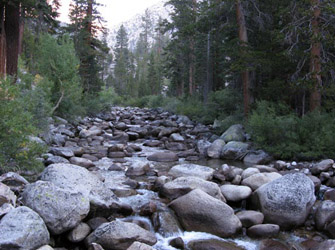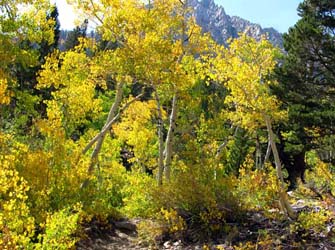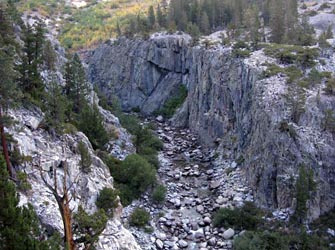The 2008 John Muir Trail Hike
Attempting the John Muir Trail in late September was not the smartest thing to do. The vibes were bad from the beginning. Concerned about early snow, leaving my single vehicle at Tuolumne Meadows was not an option. This was also true for Reds Meadow because the Mammoth mountain shuttle to Devils Postpile and Reds had already been terminated for the season. Left with few save choices, I elected to deliver a food/fuel cache at Parchers Resort near South Lake and begin the hike from Coldwater Trailhead at Mammoth Lakes. This required climbing over Duck Pass, then descending to the JMT near the Duck Creek crossing. It was here that I met with a fellow solo JMT hiker, David H., We continued together, to spend the first night at Lake Virginia in a bitterly cold wind from the south. This was my first warning that hiking the JMT at this time, of this year, was going to be decidedly unpleasant. Furthermore, I was making hard work of the hiking … lacking recent fitness training since late July on the PCT north of Yosemite. The next morning, hiking from Lake Virginia, down into Tully Hole and climbing up from Fish Creek to Silver Pass was hard work in cold windy conditions. David, much fitter than I, pushed on to make the VVR Edison Lake ferry before evening. I camped a few miles south of the Pass at a site Lucy and I had used, and enjoyed, in 2006. Another cold morning (27°F), despite this I was up early to make the 13.4 miles to Upper Bear Creek Meadow before evening. The big climb up Bear Ridge I found manageable, but the subsequent descent to Bear Creek followed by the endless climb to the Meadow gave my legs and knees much pain. After another cold night, hacking and coughing up slime in the early morning, I began to think seriously of bailing out over Piute Pass in two days time. This option became more attractive as my fourth day on the trail progressed. The climb to Selden Pass was reasonably easy, even pleasant, but the long descent down to Muir Ranch and the long drag up to the Piute Pass Trail intersection convinced me to use Piute Pass as an early escape from my ailments and the constant cold. Total hiker count on the trail for the day was four … and I camped alone at the normally busy campsite near the intersection. This location at just above 8,000’ was relatively warm which made it easy to get up early, cook, eat and break camp, but I was coughing and spitting again … a positive sign to get off the trail while I still could, with only the one 12,000’ Pass in my way. I’d been down the tortuous trail to the JMT from Piute Pass, twice, but never tried the 3,300’ ascent. The first section is through a dramatic gorge with steep granite sides, sprouting magnificent Sierra Junipers from cracks in the near vertical slabs. Also present are groves of White Fir and the occasional Red Fir throughout the lower sections of the gorge. After four hours climbing I reached the intersection of the French Canyon Trail, there meeting two couples that were also on their way out over Piute Pass |
|
They planned to spend another night below the Pass, which was also my intent and they offered to drive me back to Mammoth where my vehicle was in the Motel 6 parking lot … I hoped! I followed them up the trail toward the Pass, still 7 miles away. They turned off about half way and headed to the lowest lake in the drainage to make camp. To ensure I was ahead them in the morning (for the ride!), I pushed on to 11,000’, turned off the trail to camp at the highest Golden Trout Lake. This was a good campsite, but high, cold and exposed to the wind. Overnight the temperature fell to 21°F, and even fully dressed in all clothing, including a down jacket, I did a freeze in my 20°F rated sleeping bag from Western Mountaineering. A blessing the next morning; the sun came over the peaks early, and with no wind, my climb of 400’ to the Pass was almost fun. However, the descent to North Lake brought back the agony of my knees … the worst I’d ever felt in the mountains. But help was on the way: It turned out that the two men in the foursome (who did give me a ride to Mammoth), both in their 60’s, had knee problems … and one them was an Orthopedic Surgeon. He’d had his knees operated on and said what a mistake that was! Talk about serendipity, they quickly diagnosed my knee problems as osteoarthritis, advised me not to have any knee operations, but simply use ibuprofen (Advil, Aleve etc.) tablets before long descents … but watch for stomach upsets if the dosage is too high. I’ve since used this chemically assisted hiking technique with excellent results. |
|
Many lessons from this six day, 65 mile hike on the JMT
|
Return to Top
latest news2020 | latest news2019 | latest news2018 | latest news2017 | home | main players | contact us | sierra nevada | jmt access map | jmt planning | 2024equipment | jmt schedules | jmt2016 | jmt 2015 | jmt 2014 | jmt 2013 | jmt 2012 | jmt 2011 | jmt 2010 | jmt 2009 | jmt 2008 | jmt 2007 | jmt 2006 | jmt 2005 | jmt 2004 | jmt 2002 | mt agassiz | mt sill | mt shasta | matterhorn peak | mt egmont | nz 2016 | mt rainier | mt shuksan | mt jefferson | pct sonora nth | pct tm nth | pct wa nth | mt baker | wonder trail | mera peak | mt adams | goat rocks | cascades 2003 | mt whitney | kaibab trail | presidents | antarctica | hoover pct | recesses | highrte2015 | highrte2016 | denali89 | benson lake | videos mp4 | tremaynes |







